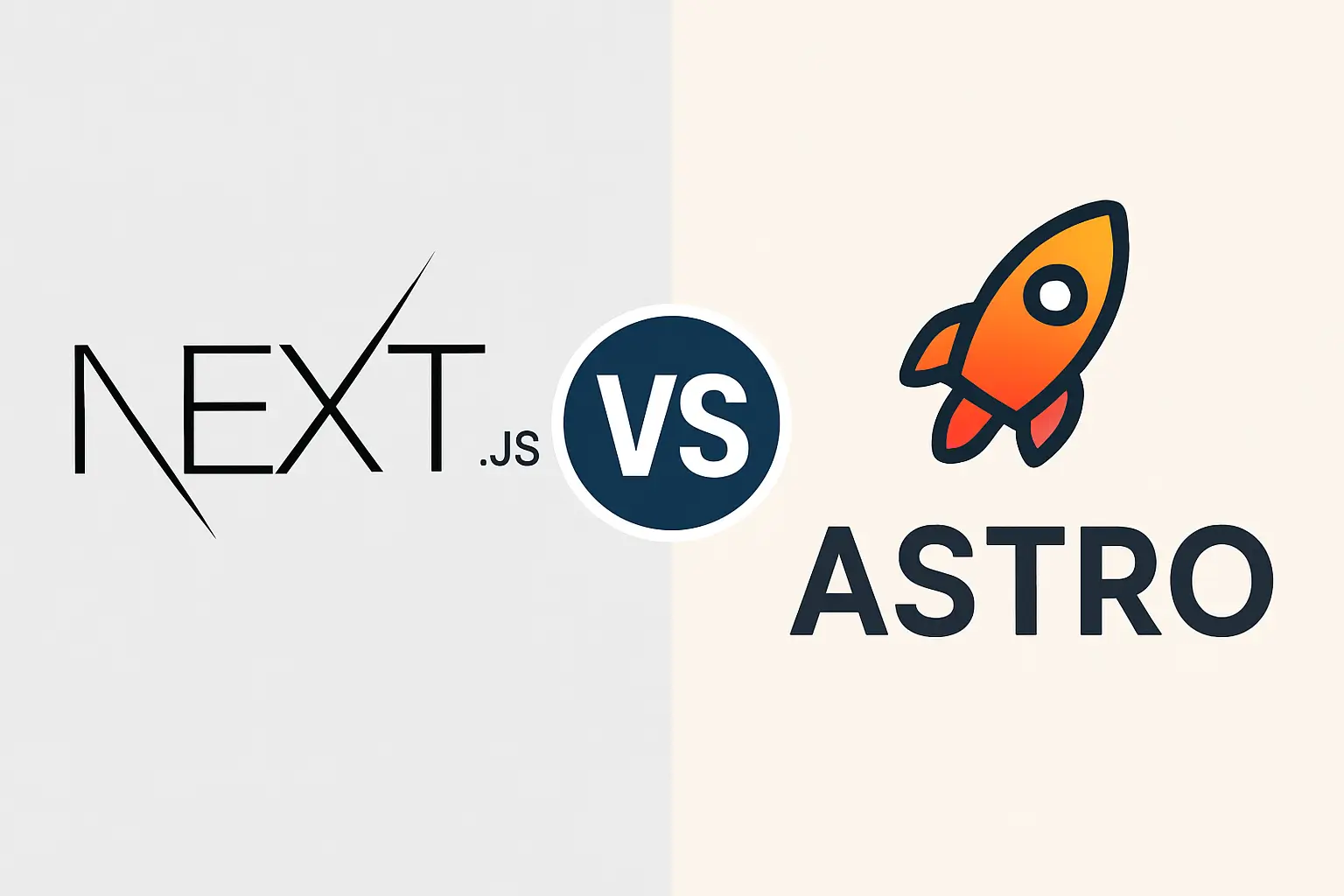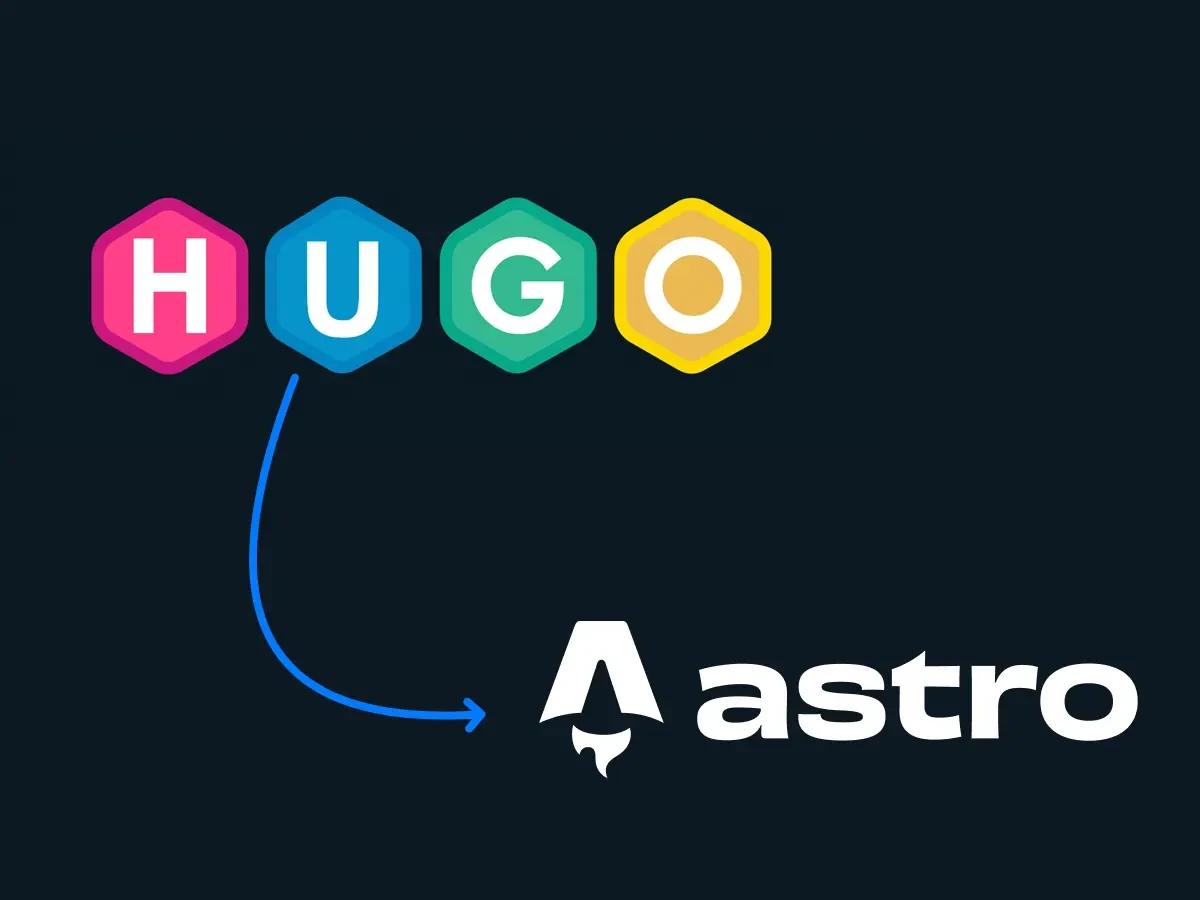· Web Development · 6 min read
Next.js vs Astro: The Complete Developer's Guide to Choosing the Right Framework in 2025
A comprehensive comparison of Next.js and Astro covering performance, DX, SEO, deployment and when to choose each in 2025.

Choosing the right JavaScript framework can make or break your web development project. In 2025, two frameworks stand out for modern web development: Next.js and Astro. While both excel at creating fast, modern websites, they take fundamentally different approaches to web development.
This comprehensive comparison will help you understand the key differences, strengths, and ideal use cases for each framework, enabling you to make an informed decision for your next project.
What is Next.js?
Next.js is a production-ready React framework developed by Vercel that provides a complete solution for building modern web applications. Since its launch in 2016, Next.js has become the go-to choice for React developers who want built-in optimization features, server-side rendering capabilities, and a streamlined development experience.
Key Features of Next.js:
- Server-Side Rendering (SSR) and Static Site Generation (SSG)
- API routes for building full-stack applications
- Automatic code splitting for optimized performance
- Built-in CSS and Sass support
- Image optimization with the Next.js Image component
- TypeScript support out of the box
- Incremental Static Regeneration (ISR)
What is Astro?
Astro is a modern web framework that prioritizes speed and developer experience through its unique “islands architecture.” Launched in 2021, Astro focuses on shipping less JavaScript to the browser while supporting multiple frontend frameworks simultaneously.
Key Features of Astro:
- Islands Architecture for selective hydration
- Multi-framework support (React, Vue, Svelte, etc.)
- Zero JavaScript by default
- Built-in performance optimization
- Component-based development
- Markdown and MDX support
- Static site generation focus
Performance Comparison: Next.js vs Astro
Astro Performance Advantages
Astro’s performance-first approach gives it significant advantages in specific scenarios:
JavaScript Bundle Size: Astro ships zero JavaScript by default, only loading JS when explicitly needed through directives like client:load. This results in dramatically smaller initial bundle sizes compared to traditional React applications.
Time to Interactive (TTI): With minimal JavaScript hydration, Astro sites become interactive faster, especially for content-heavy websites where interactivity is limited to specific components.
Core Web Vitals: Astro typically scores higher on Largest Contentful Paint (LCP) and Cumulative Layout Shift (CLS) metrics due to its static-first approach.
Next.js Performance Strengths
Next.js offers robust performance features for complex applications:
Automatic Code Splitting: Next.js automatically splits your code at the page level, ensuring users only download necessary JavaScript for each route.
Image Optimization: The built-in next/image component provides automatic WebP conversion, lazy loading, and responsive images with minimal configuration.
Incremental Static Regeneration: ISR allows you to update static content without rebuilding your entire site, combining the benefits of static and dynamic rendering.
Advanced Caching: Next.js provides sophisticated caching strategies for both static and dynamic content, improving performance for data-heavy applications.
Development Experience and Learning Curve
Next.js Development Experience
Next.js provides a familiar environment for React developers:
React Ecosystem: Full access to the React ecosystem, including state management libraries, component libraries, and development tools.
Full-Stack Capabilities: API routes enable building complete applications without separate backend services.
Mature Tooling: Extensive documentation, debugging tools, and community resources make development straightforward.
File-Based Routing: Intuitive routing system based on file structure in the pages or app directory.
Astro Development Experience
Astro offers a unique but intuitive development approach:
Framework Agnostic: Use React, Vue, Svelte, or vanilla HTML/CSS components in the same project.
Component Islands: Write interactive components only where needed, keeping the rest of your site static.
Simplified Deployment: Static output makes deployment to CDNs and static hosts extremely simple.
Learning Curve: Developers need to understand the islands architecture and when to hydrate components.
Use Cases: When to Choose Each Framework
Choose Next.js When:
Building Complex Web Applications: Next.js excels for applications requiring complex state management, user authentication, real-time features, and extensive client-side interactivity.
E-commerce Platforms: The combination of SSR, ISR, and API routes makes Next.js ideal for online stores with dynamic product catalogs and user accounts.
SaaS Applications: Full-stack capabilities and React ecosystem support make Next.js perfect for software-as-a-service platforms.
SEO-Critical Dynamic Sites: When you need both excellent SEO and dynamic functionality, Next.js provides the best balance.
Large Development Teams: Mature tooling and widespread React knowledge make Next.js easier for large teams to adopt.
Choose Astro When:
Content-Heavy Websites: Blogs, documentation sites, marketing pages, and portfolios benefit from Astro’s performance-first approach.
Multi-Framework Projects: When you want to use different frameworks for different components or migrate gradually from one framework to another.
Performance-Critical Sites: Sites where Core Web Vitals and loading speed are paramount, especially with limited interactivity requirements.
Static Site Generation: When you need the simplicity and performance of static sites with modern development tools.
Smaller Bundle Sizes: Projects where minimizing JavaScript payload is crucial for user experience or bandwidth constraints.
SEO Capabilities Comparison
Next.js SEO Features
Next.js provides comprehensive SEO capabilities:
- Server-Side Rendering ensures content is available to search engine crawlers
- Static Generation creates SEO-friendly static HTML pages
- Dynamic Meta Tags through the
next/headcomponent - Sitemap Generation with community packages
- Structured Data support through JSON-LD
Astro SEO Features
Astro’s static-first approach offers excellent SEO by default:
- Static HTML Generation provides perfect crawler accessibility
- Fast Loading Speeds improve search engine rankings
- Clean HTML Output without unnecessary JavaScript framework overhead
- Built-in Meta Tag Management
- Automatic Sitemap Generation
Both frameworks excel at SEO, but Astro has a slight edge for purely content-focused sites due to its minimal JavaScript footprint.
Ecosystem and Community
Next.js Ecosystem
- Massive Community: Large, active community with extensive tutorials, courses, and resources
- Rich Plugin Ecosystem: Thousands of Next.js-specific packages and integrations
- Corporate Backing: Strong support from Vercel ensures continued development
- Job Market: High demand for Next.js developers in the job market
Astro Ecosystem
- Growing Community: Rapidly expanding community with enthusiastic early adopters
- Framework Integration: Seamless integration with existing React, Vue, and Svelte ecosystems
- Modern Tooling: Built with modern web standards and developer experience in mind
- Innovative Features: Regular introduction of cutting-edge web development features
Deployment and Hosting Options
Next.js Deployment
- Vercel: Optimal deployment platform with zero-configuration setup
- Static Export: Can be deployed to any static hosting service
- Server Deployment: Full Node.js applications can be deployed to traditional servers
- Edge Runtime: Support for edge deployment on various platforms
Astro Deployment
- Static Hosting: Perfect fit for Netlify, Vercel, GitHub Pages, and other static hosts
- CDN Friendly: Static output is ideal for global CDN distribution
- Server-Side Rendering: Recent versions support SSR deployment on various platforms
- Build Output: Clean, optimized static files that work anywhere
Making the Final Decision
The choice between Next.js and Astro ultimately depends on your specific project requirements:
Choose Next.js if:
- You’re building a complex, interactive web application
- You need full-stack capabilities with API routes
- Your team is already proficient in React
- You require extensive third-party integrations
- SEO needs to be combined with dynamic functionality
Choose Astro if:
- Performance and loading speed are top priorities
- You’re building a content-focused website
- You want to minimize JavaScript bundle size
- You need to integrate multiple frontend frameworks
- Your site is primarily static with islands of interactivity
Conclusion
Both Next.js and Astro are excellent frameworks that solve different problems in the web development landscape. Next.js remains the superior choice for complex, interactive applications that require full-stack capabilities, while Astro shines for performance-critical, content-focused websites.
The decision shouldn’t be viewed as choosing between a “better” or “worse” framework, but rather selecting the tool that best aligns with your project’s specific requirements, team expertise, and performance goals.
As the web development ecosystem continues to evolve, both frameworks are likely to influence each other and adopt complementary features. Staying informed about their development roadmaps and regularly evaluating your project needs will help you make the best choice for each unique situation.
Remember, the best framework is the one that helps you ship quality software efficiently while meeting your users’ needs and business objectives.
Original article content provided by the user. Formatted to match the site’s post frontmatter and conventions.




